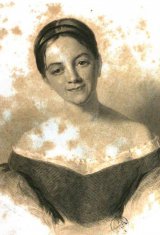The Eve of St. John
There is a flower, a magical flower,
On which love hath laid a fairy power;
Gather it on the eve of St. John,
When the clock of the village is tolling one;
Let no look be turned, no word be said,
And lay the rose-leaves under your head;
Your sleep will be light, and pleasant your rest,
For your visions will be of the youth you love best.
Four days I had not my own Love seen,—
Where, sighed I, can my wanderer have been?
I thought I would gather the magical flower,
And see him at least in my sleeping hour!—
St. John's Eve came: to the garden I flew,
Where the white roses shone with the silver dew;
The nightingale sang as I passed along—
I started to hear even her sweet song;
The sky was bright with moon and star-shine,
And the wind was sweet as a whisper of thine,
Dear love! for whose sake I stripped the tree-rose,
And softly and silently stole to repose.
No look I turned, and no word I said,
But laid the white roses under my head.
Oh, sweet was the dream that came to me then!
I dreamt of a lonely and lovely glen;
There was a clear and beautiful sky,
Such as is seen in the blue July;
To the north was a forest of darkling pine;
To the south were hills all green with the vine,
Where the ruby clusters sparkled like gems
Seen upon princely diadems;
On the rocks were goats as white as snow,
And the sheep-bell was heard in the valley below;
And like a nest in the chesnut's shade,
As just for love and contentment made,
A little cottage stood, and the tree
Shadowed it over most gracefully;
A white rose grew up beside the door,
The porch with the blossoms was covered o'er;
Methought it was your's—you were standing by:
You welcomed me, and I felt your sigh
Warm on my cheek, and our lips met,—
On mine the touch is thrilling yet!
But, alas! I awakened, and all I can do
Is to tell the sweet dream, my own Love, to you!
About this poem
From The Literary Gazette, 1822 Fragment in Rhyme, No. X
Font size:
Written on 1822
Submitted by Madeleine Quinn on February 10, 2025
- 2:02 min read
- 2 Views
Quick analysis:
| Scheme | AABCDDEEFCAAGGHHIIJJDDKKLLIIMJNNOOPPQALLRRGG |
|---|---|
| Closest metre | Iambic pentameter |
| Characters | 1,878 |
| Words | 403 |
| Stanzas | 1 |
| Stanza Lengths | 44 |
Translation
Find a translation for this poem in other languages:
Select another language:
- - Select -
- 简体中文 (Chinese - Simplified)
- 繁體中文 (Chinese - Traditional)
- Español (Spanish)
- Esperanto (Esperanto)
- 日本語 (Japanese)
- Português (Portuguese)
- Deutsch (German)
- العربية (Arabic)
- Français (French)
- Русский (Russian)
- ಕನ್ನಡ (Kannada)
- 한국어 (Korean)
- עברית (Hebrew)
- Gaeilge (Irish)
- Українська (Ukrainian)
- اردو (Urdu)
- Magyar (Hungarian)
- मानक हिन्दी (Hindi)
- Indonesia (Indonesian)
- Italiano (Italian)
- தமிழ் (Tamil)
- Türkçe (Turkish)
- తెలుగు (Telugu)
- ภาษาไทย (Thai)
- Tiếng Việt (Vietnamese)
- Čeština (Czech)
- Polski (Polish)
- Bahasa Indonesia (Indonesian)
- Românește (Romanian)
- Nederlands (Dutch)
- Ελληνικά (Greek)
- Latinum (Latin)
- Svenska (Swedish)
- Dansk (Danish)
- Suomi (Finnish)
- فارسی (Persian)
- ייִדיש (Yiddish)
- հայերեն (Armenian)
- Norsk (Norwegian)
- English (English)
Citation
Use the citation below to add this poem to your bibliography:
Style:MLAChicagoAPA
"The Eve of St. John" Poetry.com. STANDS4 LLC, 2025. Web. 22 Feb. 2025. <https://www.poetry.com/poem/213030/the-eve-of-st.-john>.






Discuss the poem The Eve of St. John with the community...
Report Comment
We're doing our best to make sure our content is useful, accurate and safe.
If by any chance you spot an inappropriate comment while navigating through our website please use this form to let us know, and we'll take care of it shortly.
Attachment
You need to be logged in to favorite.
Log In